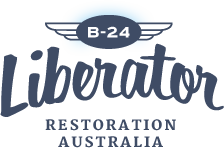B-24 Liberator Memorial Restoration Fund facts for kids
 |
|
| Formation | December 1989 (formal incorporation) |
|---|---|
| Headquarters | Werribee, Victoria, Australia |
|
President
|
Lyn Gorman |
|
Vice-President
|
Ken Abbott |
| Website | http://b24australia.org.au/ |
|
Formerly called
|
B-24 Liberator Memorial Fund |
The B-24 Liberator Memorial Restoration Fund is an Australian group. It was started in 1988. Its main goal is to find and fix up a Consolidated B-24 Liberator airplane. This plane will be shown to the public. It will be a special way to remember all the pilots and crew from countries fighting together who flew B-24 Liberators during World War II to help protect Australia.
The main parts of the airplane were found in the 1990s. The plane is currently being fixed up in Werribee, Victoria, Australia. It is kept in an old hangar from World War II. The group does not plan for the plane to fly again. Instead, it will be put on display looking just like it did when it was new.
Contents
The B-24 Liberator Plane
The B-24 Liberator was a large, four-engine bomber plane. It was built in the United States. These planes were very important during World War II. They could fly long distances and carry many bombs.
B-24s in Australia's Air Force
The Royal Australian Air Force (RAAF) used 287 B-24 planes during World War II. These planes were used for bombing missions. They also helped with secret operations. After the war, they brought prisoners of war back to Australia. The RAAF stopped using B-24s in 1948. Many of these old planes were later sold for scrap metal. Some were even used as sheds!
Meet Liberator A72-176
One special B-24 Liberator is named A72-176 (its RAAF number). Its USAAF number was 44-41956. This plane was given to the RAAF. It did not fly in any battles. Instead, it was used at RAAF Station Tocumwal to train new B-24 crews. In 1948, it was taken apart. A photographer named George Toye bought its main body. He used it as a place to live while building his house in Moe, Victoria. Later, it became a wood shed. Eventually, it just sat in his backyard.
The Story of "Bunny Hop/Flying Wolf"
Another B-24D Liberator, with the number 42-41091, was built in San Diego. It flew to Australia through Hawaii. This plane was sent to New Guinea to fight against the Japanese. On December 23, 1943, it was on a mission over Wewak. Two Japanese fighter planes attacked it. The plane's hydraulic system was damaged, and two crew members were hurt. It could not fly back to its base. So, it had to make an emergency landing at Faita Airfield.
During the war, useful parts were taken from the plane. The rest of the wreckage was left where it landed. Some parts of it can still be seen today. This plane was first called "Bunny Hop." But on its last flight, it was called "Flying Wolf." In the late 1990s, the B-24 Liberator Restoration Fund found its wings. These wings are now being used to help fix up Liberator A72-176.
Starting the Restoration Fund
In the 1980s, Eric Clark, who used to be a radio operator on a Liberator, had an idea. He suggested to his old pilot, Bob Butler, that they should create a national memorial for the Liberator. In 1988, a meeting was held at RAAF Base Wagga. The "B-24 Squadrons of Australia" group talked about the idea. They decided to try and get a Liberator plane to show to the public.
They formed a group called the "B-24 Liberator Memorial Fund Incorporated." It officially became a non-profit group in December 1989. In 1997, the word "restoration" was added to the name. This made it the "B-24 Liberator Memorial Restoration Fund."
Finding the Liberator Parts
The first part of a Liberator found by the group was a hubcap. It was found at the old RAAF Station Tocumwal in New South Wales. In 1989, the group learned about the Liberator body in Moe. After talking about buying it, the main body of the plane was bought in 1995. The tail and wings from Liberator 42-41091 were found in the late 1990s.
The Museum and Hangar
In 1993, the group started using an aircraft hangar. This hangar is located at the Werribee Satellite Aerodrome. The United States Army Air Force had built this hangar during the war. The land where the hangar sits later became part of the Western Treatment Plant. This plant is owned by Melbourne Water.
In 2012, Melbourne Water gave Places Victoria the right to build houses on the site. A school was planned for the hangar's location. But in October 2014, good news came. The Victorian Government, Melbourne Water, and the group signed an agreement. Melbourne Water agreed to give 1.475 hectares of land to the group through the government. This means the hangar and the Liberator have a permanent home.
Restoring the Aircraft
The work to fix up the B-24 Liberator has been going on since 1995. By 2015, most of the work on the plane's main body was almost finished. Workers were also busy fixing up the engine covers and doing electrical work. The restoration continues to this day, bringing the historic aircraft closer to its display ready state.
Other Projects at the Hangar
The hangar in Werribee is also home to other aircraft restoration projects.
- An Airspeed Oxford trainer plane is also being fixed up there. This plane was brought from New Zealand.
- A CAC Boomerang fighter plane, A46-147, is also at the Liberator hangar. Its owner, Nick Knight, moved it there in 2015. He had run out of space in his own garage to work on it.

